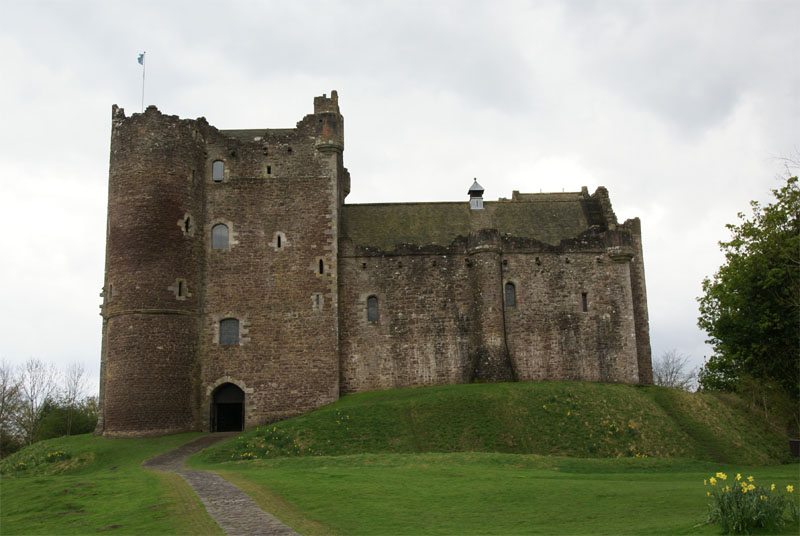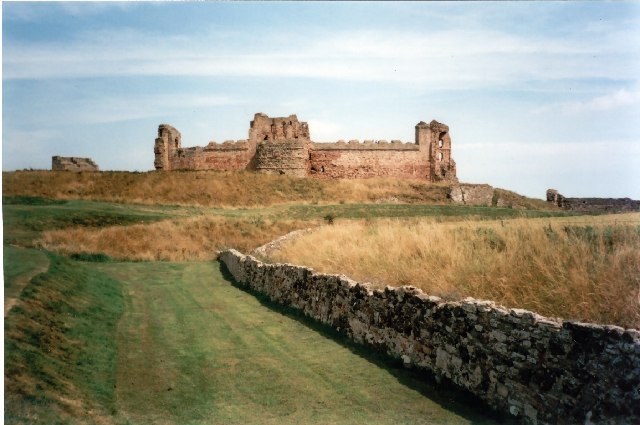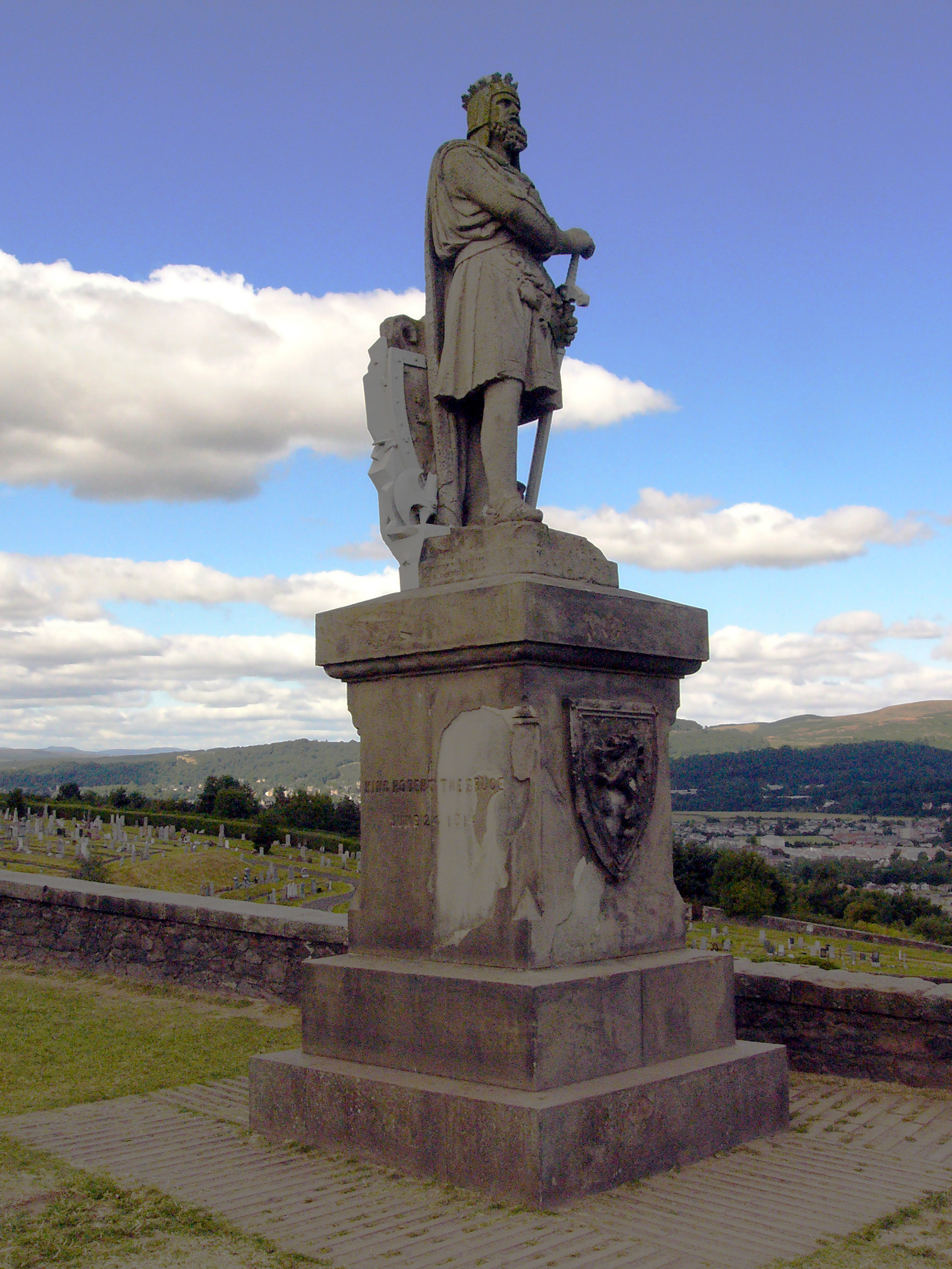|
William Douglas, 2nd Earl Of Angus
William Douglas, 2nd Earl of Angus (24 February 1398 – October 1437) was a Scottish nobleman and soldier. The son of George Douglas, 1st Earl of Angus and Princess Mary of Scotland, he was a grandson of King Robert III. The story of Angus' life is interwoven with that of his uncle and King, James I of Scotland. Angus was born about 1398 at Tantallon Castle in East Lothian. He inherited the Earldom of Angus in 1402, following his father's death of the plague whilst in English captivity, following the Battle of Homildon Hill. Return of King James In 1420, Angus was nominated as one of twenty-one noblemen to be delivered as hostages to the English court as security for the ransom of King James I. James had been captured by the English in 1406, and was held by first Henry IV of England, and latterly by his son Henry V of England. During the king's captivity, Scotland was ruled by his uncle Robert Stewart, Duke of Albany, who had been in no hurry to pay his nephew's rans ... [...More Info...] [...Related Items...] OR: [Wikipedia] [Google] [Baidu] |
James Douglas, 3rd Earl Of Angus
James Douglas, 3rd Earl of Angus, Lord of Liddesdale and Jedburgh Forest (1426–1446) was a Scottish nobleman. He was the son of William Douglas, 2nd Earl of Angus and Margaret Hay of Yester. Angus succeeded at the age of eleven years and was soon involved in strife with his Black Douglas cousins. He was forfeited of his estates by James II in 1445, under the influence of his near cousin William Douglas, 8th Earl of Douglas. The Earl of Douglas was trying to consolidate the power which he had gained through the murder of his cousins at the "Black Dinner" at Edinburgh Castle, sanctioned by the king and his own father James the Gross, 7th Earl of Douglas. It has been suggested that the feud between the Black and Red Lines of the House of Douglas was encouraged by Bishop Kennedy of St. Andrews as a method of curtailing the power of unruly magnates, and ensuring continued Stewart reign.Maxwell, Vol II, pp12-13 Kennedy was a first cousin through Angus' grandmother, Princess Mary ... [...More Info...] [...Related Items...] OR: [Wikipedia] [Google] [Baidu] |
Robert Stewart, Duke Of Albany
Robert Stewart, Duke of Albany (c. 1340 – 3 September 1420) was a member of the Scottish royal family who served as regent (at least partially) to three Scottish monarchs ( Robert II, Robert III, and James I). A ruthless politician, Albany was widely regarded as having murdered his nephew, the Duke of Rothesay, and brother to the future King James I of Scotland. James was held in captivity in England for eighteen years, during which time Albany served as regent in Scotland, king in all but name. He died in 1420 and was succeeded by his son, Murdoch Stewart, Duke of Albany, who was executed for treason when James returned to Scotland in 1425, almost causing the complete ruin of the Albany Stewarts. Early life and ancestry Robert Stewart was the third son of the future King Robert II of Scotland (1316–1390) and of Elizabeth Mure of Rowallan. His parents' marriage was deemed uncanonical at first, which, in some circles, gave their children and descendants the label of i ... [...More Info...] [...Related Items...] OR: [Wikipedia] [Google] [Baidu] |
Lord Warden Of The Marches
The Lord Warden of the Marches was an office in the governments of Scotland and England. The holders were responsible for the security of the border between the two nations, and often took part in military action. They were also responsible, along with Conservators of the Truce, for administering the special type of border law known as March law. The Marches on both sides of the border were traditionally split into West, Middle, and East, each with their own warden answerable to the Lord Warden-general. The English Western March was based on Carlisle and the Eastern March on Berwick-upon-Tweed. The offices became unnecessary after the union of the crowns of England and Scotland under King James in 1603. For England Warden of the Marches * Robert de Clifford (1297–) (died 1314) * John de Warenne, 7th Earl of Surrey (1327–) * Henry de Percy, 2nd Baron Percy (1328–) * Ralph Neville, 2nd Baron Neville de Raby and Henry de Percy, 2nd Baron Percy (1334–) (jointly) * Gi ... [...More Info...] [...Related Items...] OR: [Wikipedia] [Google] [Baidu] |
Henry VI Of England
Henry VI (6 December 1421 – 21 May 1471) was King of England from 1422 to 1461 and 1470 to 1471, and English claims to the French throne, disputed King of France from 1422 to 1453. The only child of Henry V of England, Henry V, he succeeded to the Throne of England, English throne at the age of eight months, upon his father's death, and to the List of French monarchs, French throne on the death of his maternal grandfather, Charles VI of France, Charles VI, shortly afterwards. Henry was born during the Hundred Years' War (1337–1453), he is the only English monarch to have been crowned King of France, following his coronation at Notre-Dame de Paris in 1431 as Henry II. His early reign, when England was ruled by a Regency government, 1422–1437, regency government, saw the pinnacle of English power in Kingdom of France, France. However, setbacks followed once he assumed full control in 1437. The young king faced military reversals in France, as well as political and financia ... [...More Info...] [...Related Items...] OR: [Wikipedia] [Google] [Baidu] |
Holyrood Abbey
Holyrood Abbey is a ruined abbey of the Canons Regular in Edinburgh, Scotland. The abbey was founded in 1128 by David I of Scotland. During the 15th century, the abbey guesthouse was developed into a List of British royal residences, royal residence, and after the Scottish Reformation the Palace of Holyroodhouse was expanded further. The abbey church was used as a parish church until the 17th century, and has been ruined since the 18th century. The remaining walls of the abbey lie adjacent to the palace, at the eastern end of Edinburgh's Royal Mile. The site of the abbey is protected as a scheduled monument. Etymology of name Rood is a word for the cross on which Jesus Christ was crucified; thus the name Holyrood (cross), Holyrood is equivalent to "true cross, Holy Cross". History Legend relates that in 1127, while King David I was hunting in the forests to the east of Edinburgh during the Feast of the Cross, he was thrown from his horse after it had been startled by a har ... [...More Info...] [...Related Items...] OR: [Wikipedia] [Google] [Baidu] |
Inverness
Inverness (; ; from the , meaning "Mouth of the River Ness") is a city in the Scottish Highlands, having been granted city status in 2000. It is the administrative centre for The Highland Council and is regarded as the capital of the Highlands. Historically it served as the county town of the Counties of Scotland, county of Inverness-shire. Inverness lies near two important battle sites: the 11th century, 11th-century battle of Blar Nam Feinne, Blàr nam Fèinne against Norway which took place on the Aird, and the 18th century Battle of Culloden which took place on Culloden, Highland#Battlefield of Culloden, Culloden Moor. It is the northernmost city in the United Kingdom and lies within the Great Glen (Gleann Mòr) at its northeastern extremity where the River Ness enters the Beauly Firth. With human settlement dating back to at least 5,800 BC, Inverness was an established self-governing settlement by the 6th century with the first Royal Charter being granted by Dabíd mac ... [...More Info...] [...Related Items...] OR: [Wikipedia] [Google] [Baidu] |
Alexander Of Islay, Earl Of Ross
Alexander of Islay or Alexander MacDonald (died 1449; ) was a medieval Scottish nobleman who succeeded his father Domhnall of Islay as Lord of the Isles (1423–1449), later rising to the rank of Earl of Ross (1436–49). His lively career, especially before he attained the earldom of Ross, led Hugh MacDonald, the 17th century author of ''History of the MacDonalds'', to commemorate him as "a man born to much trouble all his lifetime". Alexander allied himself with King James I of Scotland against the power of the Albany Stewarts in 1425 but, once the Albany Stewarts were out of the way, Alexander quickly found himself at odds with the new king. War with King James would initially prove Alexander's undoing, and would see the King's power in Scotland greatly increased, but at the Battle of Inverlochy Alexander's army prevailed against the forces of the King. Alexander died in 1449, having greatly extended his family's landed wealth and power. He was buried, not in the Isles o ... [...More Info...] [...Related Items...] OR: [Wikipedia] [Google] [Baidu] |
Lord Of The Isles
Lord of the Isles or King of the Isles ( or ; ) is a title of nobility in the Baronage of Scotland with historical roots that go back beyond the Kingdom of Scotland. It began with Somerled in the 12th century and thereafter the title was held by a series of his descendants, the Norse-Gaelic rulers of the Isle of Man and Argyll and the islands of Scotland in the Middle Ages. They wielded sea-power with fleets of galleys ( birlinns). Although they were, at times, nominal vassals of the kings of Norway, Ireland, or Scotland, the island chiefs remained functionally independent for many centuries. Their territory included much of Argyll, the Isles of Arran, Bute, Islay, the Isle of Man, Hebrides ( Skye and Ross from 1438), Knoydart, Ardnamurchan, and the Kintyre peninsula. At their height they were the greatest landowners and most powerful lords after the kings of England and Scotland. The end of the MacDonald Lords came in 1493 when John MacDonald II had his ancestr ... [...More Info...] [...Related Items...] OR: [Wikipedia] [Google] [Baidu] |
Isabella, Countess Of Lennox
Isabella of Lennox (died 1458) was the ruler of Lennox, at least from 1437 to 1458, and last in the line of Mormaers or native Scottish rulers. As the wife of Murdoch Stewart, 2nd Duke of Albany (died 1425), she was also Duchess of Albany (1420–1425), but in 1425 her family would be almost completely destroyed when her husband, father and two sons were executed by King James I of Scotland because of their rebellion. Only one son, James the Fat, would escape their family's punishment, and he would die in exile in Ireland. Isabella succeeded in escaping the fate of her family, and would eventually regain her title and estates, retiring to her castle in Loch Lomond where she raised her grandchildren. She would eventually live to see the assassination of her family's opponent, King James. Though none of her four sons survived her, her grandson Andrew Stewart, 1st Lord Avandale, became Lord Chancellor of Scotland. Early life Isabella was the daughter of Donnchadh, Earl of L ... [...More Info...] [...Related Items...] OR: [Wikipedia] [Google] [Baidu] |
Donnchadh, Earl Of Lennox
Donnchadh of Lennox was the Mormaer of Lennox from 1385 to 1425. He was a son of Baltar mac Amlaimh and Margaret, daughter of Domhnall, Earl of Lennox. When Domhnall of Lennox died in 1365, Donnchadh's mother Margaret became ruler of Lennox. It had been Domhnall's intention that the marriage would eventually allow the succession of a son, i.e. Donnchadh, but it is probable that Baltar intended to rule in his turn. It is not known how relations deteriorated, but it seems that Donnchadh got impatient. In the summer of 1384, King Robert II issued two charters formally conferring the Mormaerdom on Baltar. However, a year later he and his wife Margaret resigned the Mormaerdom over to their eldest son Donnchadh, and hence Donnchadh became ruler. However, in 1388, Baltar and Margaret were handed custody of the Mormaerdom for the remainder of their lives, with Donnchadh retaining the title. Donnchadh was confined to a stronghold in Loch Lomond, Inchmurrin castle. Donnchadh was forced ... [...More Info...] [...Related Items...] OR: [Wikipedia] [Google] [Baidu] |
Murdoch Stewart, 2nd Duke Of Albany
Murdoch Stewart, Duke of Albany () (1362 – 25 May 1425) was a leading Scottish nobleman, the son of Robert Stewart, Duke of Albany, and the grandson of King Robert II of Scotland, who founded the Stewart dynasty. In 1389, he became Justiciar of Scotia, Justiciar North of the Forth. In 1402, he was captured at the Battle of Homildon Hill and would spend 12 years in captivity in England. After his father died in 1420, and while the uncrowned King James I of Scotland was himself held captive in England, Stewart served as Governor of Scotland until 1424, when James was finally ransomed and returned to Scotland. However, in 1425, soon after James's coronation, Stewart was arrested, found guilty of treason, and executed, along with two of his sons. His only surviving heir was James the Fat, who escaped to Antrim, County Antrim, Antrim, Ireland, where he died in 1429. Stewart's wife Isabella of Lennox survived the destruction of her family. She lived to see the assassination of James ... [...More Info...] [...Related Items...] OR: [Wikipedia] [Google] [Baidu] |
Stirling Castle
Stirling Castle, located in Stirling, is one of the largest and most historically and architecturally important castles in Scotland. The castle sits atop an Intrusive rock, intrusive Crag and tail, crag, which forms part of the Stirling Sill geological formation. It is surrounded on three sides by steep cliffs, giving it a strong defensive position. Its strategic location, guarding what was, until the 1890s, the lowest bridging point, farthest downstream crossing of the River Forth, has made it an important fortification in the region from the earliest times. Most of the principal buildings of the castle date from the fifteenth and sixteenth centuries. A few structures remain from the fourteenth century, while the outer defences fronting the town date from the early eighteenth century. Before the union with England, Stirling Castle was also one of the most used of the many Scottish royal residences, very much a palace as well as a fortress. Several List of Scottish monarchs, Sc ... [...More Info...] [...Related Items...] OR: [Wikipedia] [Google] [Baidu] |








